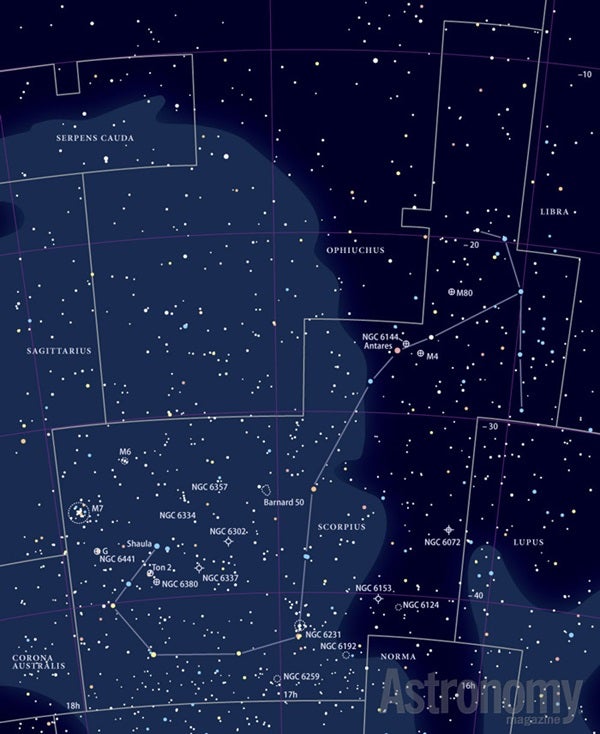Targets for August 7–14, 2014
Naked eye and Binoculars: Corona Borealis
Small telescope: Globular cluster M9
Large telescope: The Lobster Nebula (NGC 6357)
This week’s naked-eye object is the small but relatively bright constellation Corona Borealis the Northern Crown.
Three constellations border Corona Borealis: Boötes, Hercules, and Serpens. The Northern Crown is not a large constellation. It covers only 179 square degrees of sky, which is about 0.4 percent. Its size ranks it 73rd out of the 88 constellations in terms of area that cover the sky.
But what Corona Borealis lacks in size it makes up for in brightness. It ranks as the 11th-brightest star pattern. Twenty-two of its stars are more luminous than magnitude 5.5.
The constellation contains one star in the list of top 200 brightest: Alphecca (Alpha [α] Coronae Borealis) ranks 65th, and shines at magnitude 2.2. Some refer to this star as Gemma. The only other named star in Corona Borealis is magnitude 3.7 Nusukan (Beta [β] Coronae Borealis).
The best time of year to see this constellation is late spring, but it remains easy to see through the summer. It lies opposite the Sun’s position in the sky May 19. Conversely, the Sun lies in Corona Borealis’ part of the sky around November 18, making this a poor time to observe it.
Corona Borealis is completely visible to anyone located north of latitude 50° south. The only places it can’t be seen at all lie south of latitude 64° south.
A seldom-observed globular
This week’s small-telescope target is globular cluster M9 in Ophiuchus. It shines just outside naked-eye range at magnitude 7.6, and it measures 9.3′ across.
The ninth entry on Charles Messier’s fabled list lies 3.5° southeast of magnitude 2.4 Eta (η) Ophiuchi and just east of dark nebula Barnard 64. The nearness of this obscuring cloud of dust probably reduces M9’s light by a full magnitude.
Through a 4-inch telescope at 200x, you’ll note the cluster’s bright, broad, irregularly illuminated central region. M9’s edge looks irregular even at lower magnifications. The core appears slightly oval with a north-south orientation.
Celestial lobster
This week’s large-telescope target is the Lobster Nebula in Scorpius. Also known as the War and Peace Nebula, this emission nebula’s catalog designation is NGC 6357.
Whatever you call it, you’ll find this great object 3.3° north-northwest of magnitude 1.6 Shaula (Lambda [λ] Scorpii). It measures 25′ across, giving it an area 65 percent as large as the Full Moon.
Sir John Herschel discovered and cataloged the Lobster Nebula in 1837, during his 4-year stay at the Cape of Good Hope.
The nebula attained one of its names because of its appearance in mid-infrared wavelengths as seen by Midcourse Space Experiment (MSX) scientists. They worked for the Ballistic Missile Defense Organization, of which the MSX satellite was an experiment. They said the bright portion of the nebula, to the northwest, looked like a dove, while the mid-infrared filaments to the east seemed to trace out a human skull. You can still see the “dove” in the 2MASS near-infrared image, but the “skull” is not nearly as apparent as in the MSX image.
NGC 6357 surrounds the magnitude 9.6 open cluster Pismis 24. Some of this cluster’s bright blue stars are among the most massive ever discovered. For example, astronomers using the Hubble Space Telescope discovered a double star weighing 100 solar masses.
Although the apparent size of the Lobster Nebula — 25′ — is 65 percent of the Full Moon, through an 11-inch telescope you’ll see only one-tenth its extent. The nebula’s brightest region lies to the west of center. Use a nebula filter to improve the view. Note the four 7th-magnitude stars in a line south of the nebula. The northernmost, magnitude 7.1 SAO 208790, lies atop NGC 6357’s center.
Expand your observing at Astronomy.com
StarDome
Check out Astronomy.com’s interactive StarDome to see an accurate map of your sky. This tool will help you locate this week’s targets.
The Sky this Week
Get a daily digest of celestial events coming soon to a sky near you.
Observing Talk
After you listen to the podcast and try to find the objects, be sure to share your observing experience with us by leaving a comment at the blog or in the Reader Forums.











